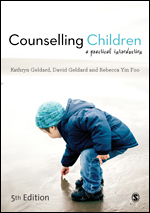Counselling Children
A Practical Introduction
Kathryn Geldard
David Geldard - Retired Counselling Psychologist and Trainer
Rebecca Yin Foo - Educational and Developmental Psychologist
The definitive guide to the skills and techniques used when working with children experiencing emotional problems, this book covers all you need to know about, including:
- The goals for counseling children and the child-counselor relationship
- Practice frameworks for working effectively with children
- Play therapy and the use of different media and activities
- Building self-esteem and social skills through the use of worksheets
The new Fifth Edition has been updated to include:
- A new chapter on technology (its influence on children and ways that technology can be used during counseling)
- New content on issues of diversity and difference in counseling children
- The different contexts in which counseling children occur
- Discussion of concepts of well-being and resilience
- Updated references and research
The book is supported by a new Companion Website that provides training materials and handouts on a range of skills for counseling children including: helping the child to tell their story and tray work, the use of miniature animals, the use of clay, and helping the child to change thoughts and behavior.
This highly practical guide is vital reading for counselors, psychologists, social workers, occupational therapists, nurses, and teachers working or training to work with children.
Available formats
See what’s new to this edition by selecting the Features tab on this page. Should you need additional information or have questions regarding the HEOA information provided for this title, including what is new to this edition, please email sageheoa@sagepub.com. Please include your name, contact information, and the name of the title for which you would like more information. For information on the HEOA, please go to http://ed.gov/policy/highered/leg/hea08/index.html.
For assistance with your order: Please email us at textsales@sagepub.com or connect with your SAGE representative.
SAGE
2455 Teller Road
Thousand Oaks, CA 91320
www.sagepub.com

